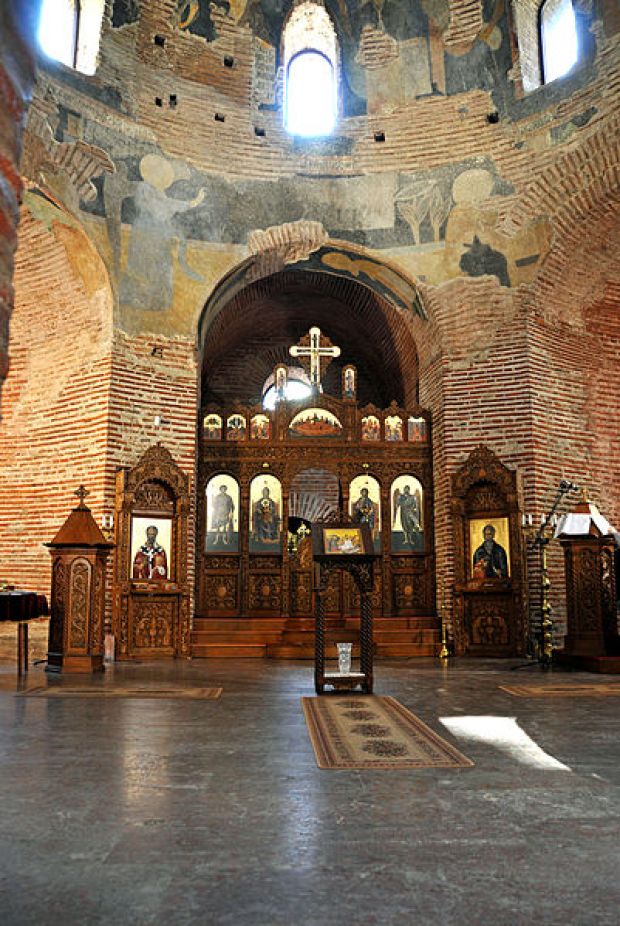All Byzantine Churches, both Catholic and Orthodox, have an iconostasis. Mr Esparza explains the theology behind each level.
From Aleteia
By Daniel Esparza
Tracing the evolution of the icon screen — and the theology behind its five levels.Step into an Eastern Christian church and you’ll see a wall — often gilded, radiant, and filled with faces — that divides the sanctuary from the people. This is the iconostasis. More than a liturgical screen, it is a theological architecture, a catechism in color, and a window into the divine.
The word iconostasis comes from the Greek eikon (image) and stasis (to stand, or even a “standing place”), meaning “place of icons.” Its spiritual meaning goes far deeper.
Russian theologian Pavel Florensky once described it as the threshold between two worlds: the visible and the invisible. What may appear to be a barrier is in fact a passage — a visual proclamation of the mystery of salvation.

From barrier to revelation
The roots of the iconostasis stretch back to the structure of the Jerusalem Temple, where a veil separated the Holy of Holies from the people. Early Christian churches adopted this spatial symbolism: a low barrier or curtain marked the division between the nave and the sanctuary.
By the 9th century, after the defeat of iconoclasm (a movement that destroyed images of the divine, believing them to be sacrilegious), icons were returned to prominence, and this once simple screen began to grow — both in height and meaning.
By the 15th century in Russia, the iconostasis had evolved into a monumental wall of icons arranged in strict theological order, often rising to five or more levels, with variants depending on many factors.
In any case, the iconostasis was never just decoration but a liturgical and dogmatic statement — telling, in visual form, the story of salvation from Creation to the Last Judgment.
A guide to the five levels
Reading an iconostasis is reading a Gospel in images. You can begin at the top or the bottom — either way, it invites you into a sacred conversation.
1. The Patriarchs (top tier)
At the summit, you’ll often find “The Hospitality of Abraham,” also known as the Trinity of the Hebrew Bible, flanked by patriarchs like Adam, Noah, and Moses. This row represents the divine plan from the beginning — a prefiguration of Christ’s coming.
2. The Prophets
Beneath them are the prophets, such as Isaiah, Ezekiel, and Daniel, holding scrolls with their messianic prophecies. At the center stands the Theotokos (Mother of God), either shown pregnant with Christ (Our Lady of the Sign) or enthroned with Him, signifying the fulfillment of those prophecies.
3. The Deësis (“Intercession”)
This is the spiritual heart of the iconostasis. Christ is shown in majesty, enthroned as Judge and Savior. On either side stand the Virgin Mary and John the Baptist, interceding for humanity. They are joined by apostles, angels, and great saints. Together, they form the Church triumphant, united in prayer for the world.
4. The Feasts
This row illustrates the great events of Christ’s life, from the Annunciation and Nativity to the Resurrection and Ascension. These are historical moments and liturgical celebrations, doors into the eternal made present in the Church’s worship.
5. The Local Saints (bottom tier)
Closest to the people are the icons of saints especially beloved by the local community — patrons of the church, regional wonderworkers, or martyrs. At the center are the Royal Doors, always depicting the Annunciation and the four Evangelists. Above them is usually the Last Supper, pointing to the Eucharist celebrated just behind them.
A sacred drama in stillness
The iconostasis does not separate so much as it stages a liturgical drama. Through it, the faithful participate in heaven’s worship. As St. Paul writes, “He chose us in Him before the foundation of the world, to be holy and blameless in His sight” (Ephesians 1:4).
The iconostasis tells that very story — from divine intention to human redemption. Whether humble or grand, it always speaks the same truth: God is not far. He is here, in images, in liturgy, and in the loving community.


No comments:
Post a Comment
Comments are subject to deletion if they are not germane. I have no problem with a bit of colourful language, but blasphemy or depraved profanity will not be allowed. Attacks on the Catholic Faith will not be tolerated. Comments will be deleted that are republican (Yanks! Note the lower case 'r'!), attacks on the legitimacy of Pope Leo XIV as the Vicar of Christ, the legitimacy of the House of Windsor or of the claims of the Elder Line of the House of France, or attacks on the legitimacy of any of the currently ruling Houses of Europe.